Egyptian - Recent acquisitions - Lehrsammlung - Photo gallery
Image database with photographs of ancient art and antiquities
Our image database provides photographs of ancient art and antiquities for press releases as well as for private use. All artefacts sold in our gallery are documented through professional photographs. The resulting image library contains numerous ancient Egyptian, Greek and Roman antiquities as well as ancient coins. The time span from Stone Age, over Bronze Age and Classical Antiquity until Late Antiquity is covered.The photo gallery aims at providing a vast visual archive equipped with filters and search tools. You are most welcome to search the constantly growing number of artefacts in the image library. We are also happy to authorize hyperlinks from your webpage / forum to the objects depicted in our gallery. For this purpose, please send us a short notification prior to placing a hyperlink. For almost every object high definition photographs are available and can be provided e.g. to document your collection or for scientific papers or popular science articles. If you are interested in using pictures for publications, print media or other purposes, please contact us and we will be happy to assist you.
-
 Egyptian amulet of Anubis
Egyptian amulet of AnubisThe amulet from the Late Period of Ancient Egypt was supposed to protect the dead on their way to the afterlife. From a British private museum.
Price: on request Egyptian amulet of Taweret
Egyptian amulet of TaweretIt shows the goddess of childbirth in the form of a pregnant hippopotamus. The amulet from the Late Period of Ancient Egypt should exert a protective function. From a British private museum.
Price: on request Egyptian amulet of Thoth
Egyptian amulet of ThothIbis headed god of knowledge and writing. 26th to 30th dynasty of Ancient Egypt. From a British private museum.
Price: on request Egyptian pataikos
Egyptian pataikosGod or god-like dwarf. The figurine was supposed to have a magical protective function. 26th to 30th dynasty of Ancient Egypt. From a British private museum.
Price: on request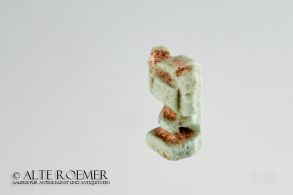 Egyptian amulet of Shu
Egyptian amulet of ShuGod of the air and the sun. The highly stylized figurine shows the ancient Egyptian god on his knees, the arms raised towards the sun. From a British private museum.
Price: on request Egyptian amulet of a falcon
Egyptian amulet of a falconThe falcon in Egyptian art can be a depiction of the god Horus or symbolize the soul of the pharao. Falcon amulets are known from the earliest times in Egyptian history. However this speicmen dates to the Late Dynastic Period of Ancient Egypt.
Price: on request Egyptian amulet of a hare
Egyptian amulet of a hareThis type of amulet was popular in the Late Dynastic Period of Ancient Egypt. It should endow its wearer with fertility and rapidity of movement. The piece was exhibited in an early 20th century private museum.
Price: on request Egyptian scarab amulet
Egyptian scarab amuletNice amulet from the Late Dynastic Period of Ancient Egypt. The scarab was exhibited in an early 20th century private museum.
Price: on request Egyptian ushabti from the Third Intermediate Period
Egyptian ushabti from the Third Intermediate PeriodFunerary statuette of faience with black paint. The opposed hands might indicate Tanis as origin. Third Intermediate Period of Ancient Egypt.
Price: on request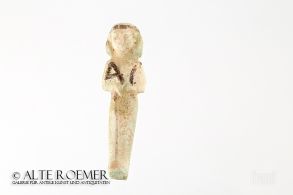 Egyptian ushabti
Egyptian ushabtiFunerary statuette of faience. The opposed hands might indicate Tanis as origin. Third Intermediate Period of Ancient Egypt.
Price: on request Scarab with geometric motive
Scarab with geometric motiveThe lower side exhibits wrapped cords. A nice example of Egyptian art during the Second Intermediate Period. This scarab is described in the catalogue of Irène Gautier-Vodoz.
Price: on request Scarab with lotus motive
Scarab with lotus motiveAncient Egyptian amulet seal with beautiful motive. Six lotus flowers are forming volutes. This scarab is described in the catalogue of Irène Gautier-Vodoz.
Price: on request Egyptian Scarab
Egyptian ScarabThe Egyptian scarab has a central cross on the stamp side. The piece dates to the 21st dynasty of Ancient Egypt. It is described in the catalogue of Gautier-Vodoz.
Price: on request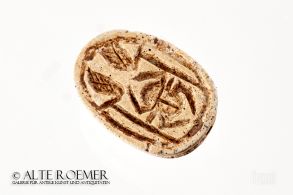 Scarab with scarab motive
Scarab with scarab motiveThe stamp side shows a scarab with two uraeus snakes. This scarab is described in the catalogue of Irène Gautier-Vodoz.
Price: on request Small scarab amulet with Isis hieroglyphs
Small scarab amulet with Isis hieroglyphsThe tiny amulet dates to the New Kingdom. It bears the glyphs for the goddess Isis. This scarab is described in the catalogue of Irène Gautier-Vodoz.
Price: on request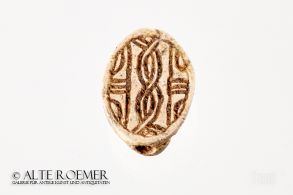 Scaraboid with twisted cord
Scaraboid with twisted cordScaraboid seal amulet with a twisted cord motive. This scarab is described in the catalogue of Irène Gautier-Vodoz.
Price: on request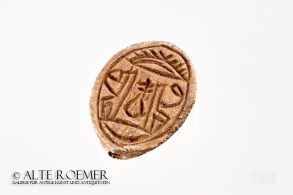 Scaraboid with Red Crowns of Lower Egypt
Scaraboid with Red Crowns of Lower EgyptThe hieroglyphs on the lower side symbolize the rule over Lower Egypt. The rising sun is symbolized above. This scaraboid is described in the catalogue of Irène Gautier-Vodoz.
Price: on request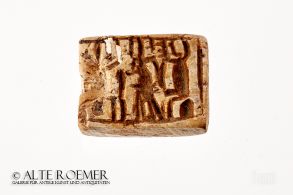 Egyptian steatite plaque
Egyptian steatite plaqueThe protective amulet shows the god Bes between two seated monkeys. Late Period of ancient Egypt. This piece is described in the catalogue of Irène Gautier-Vodoz.
Price: on request Egyptian amulet of Anubis
Egyptian amulet of AnubisThe amulet from the Late Period of Ancient Egypt was supposed to protect the dead on their way to the afterlife. From a British private museum.
Price: on request Egyptian amulet of Taweret
Egyptian amulet of TaweretIt shows the goddess of childbirth in the form of a pregnant hippopotamus. The amulet from the Late Period of Ancient Egypt should exert a protective function. From a British private museum.
Price: on request Egyptian pataikos
Egyptian pataikosGod or god-like dwarf. The figurine was supposed to have a magical protective function. 26th to 30th dynasty of Ancient Egypt. From a British private museum.
Price: on request Egyptian bronze figurine of Nefertem
Egyptian bronze figurine of NefertemA major cult in Memphis saw the god related to fragrances. He is depicted here as youthful god in human form. Nice piece from the Late Period of ancient Egypt.
Price: on request Egyptian fingerring from the Amarna period
Egyptian fingerring from the Amarna periodMade of colourful turquoise fayence. Two fully modelled crocodiles adorn the plate. Perfect preservation including original black paint.
Price: on request Egyptian tomb relief from Memphis
Egyptian tomb relief from MemphisThe flat relief shows an offering scene and above a hieroglyphic text describing the deceased Ptah-nefer, the priest and the offerings. A translation has been made by the renowned Egyptologist professor Kurth. The work of art dates to the 26th dynasty. It is adopting the style of the Old Kingdom.
Price: on request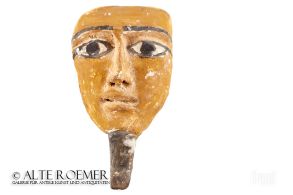 Egyptian sarcophagus mask
Egyptian sarcophagus maskImpressive wood relief of an idealized face. Polychrome paint. The mask was part of a sarcophagus lid from the Late Period of Ancient Egypt.
Price: on request Scarab with standing figure
Scarab with standing figureThe scarab amulet dates to the Late Period. The lower side shows a stading figure, possibly the goddess Neith.
Price: on request Ramesside Scarab
Ramesside ScarabEgyptian scarab from the 19th to 20th dynasty. With horse and hieroglyphs.
Price: on request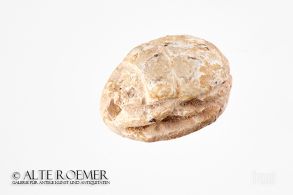 Scarab with inscription Amun Re
Scarab with inscription Amun ReInteresting scarab from the New Kingdom. With hieroglyphs reading Amun Re, main god of Theben, and lotus flower.
Price: on request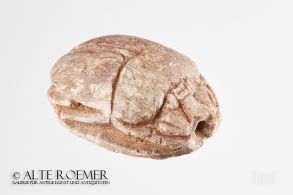 Scarab with inscription
Scarab with inscriptionThe lower side bears a hieroglyph inscription. Nice piece from the Freemark collection. New Kingdom.
Price: on request Scarab with cross symbol
Scarab with cross symbolA piece from the Ramesside Period to the early Third Intermediate Period of ancient Egypt. Great early 20th century provenance.
Price: on request Scarab with blue fayence glaze
Scarab with blue fayence glazeThe piece is from the Third Intermediate Period or the Late Period of ancient Egypt. The inscription refers to Amun-Re, the main god of Theben. The glaze is shining in vivid blue colour.
Price: on request Scarab with god Heh and cartouche
Scarab with god Heh and cartoucheInteresting motive showing the kneeling god of endlessness with palm stem in both hands. Above him the cartouche of pharao Mencheperre. Around the 18th dynasty of ancient Egypt.
Price: on request Egyptian faience figurine of the dwarf god pataikos
Egyptian faience figurine of the dwarf god pataikosThe figurine was supposed to have a magical protective function. 26th to 30th dynasty of Ancient Egypt. From a British private museum.
Price: on request Egyptian amulet of Shu
Egyptian amulet of ShuGod of the air and the sun. The highly stylized figurine shows the ancient Egyptian god on his knees, the arms raised towards the sun. From a British private museum.
Price: on request Scarab with sphinx and Maat
Scarab with sphinx and MaatThe piece from the Ramesside period shows the goddess of truth and justice. Next to her is a name, probably that of pharao Mencheperre, who is famous as Thutmosis III.
Price: on request Scarab of pharao Seti I.
Scarab of pharao Seti I.The Egyptian scarab bears a hieroglyphic inscription which can be read as the name of pharao Seti I. From the Ramesside period, around 1300 BC.
Price: on request

